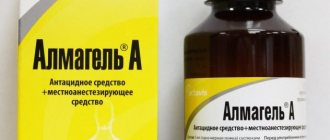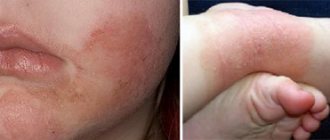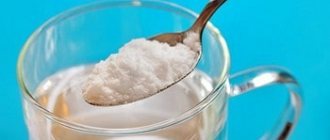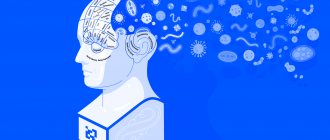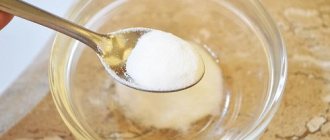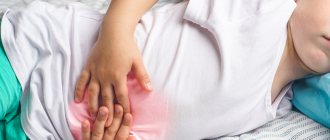Causes of colitis
Colitis is a polyetiological disease. Its development is influenced by a whole range of factors.
The following causes are typical for acute colitis in children:
- intestinal infection caused by Shigella, Salmonella, Escherichia and other microorganisms;
- side effects of certain groups of medications;
- disturbance of blood supply and nervous innervation of the large intestine.
The chronic form of this disease is caused by the following factors:
- previous intestinal infection;
- helminthiases;
- improper and irregular nutrition;
- food allergies;
- intolerance to certain foods (celiac disease and other enzymatic deficiencies);
- developmental anomalies of the gastrointestinal tract;
- myasthenia gravis, cerebral palsy and other diseases of the central nervous system;
- endocrine and systemic diseases;
- prolonged stress, physical strain.
The most common causes of abdominal pain in children
The most common causes of abdominal pain are: inflammatory damage to the tissues or peritoneum (appendicitis, colitis, pancreatitis), hypoxia (for example, with a strangulated hernia, intussusception), stretching of the organ capsule (for example, acute enlargement of the liver), hyperperistalsis (spasm, colic) , stretching of the intestinal wall, stretching of its lumen, for example, due to the accumulation of gases (volvulus, intussusception), tension of the mesenteric root, which is especially susceptible to painful irritation, radiating pain in diseases localized outside the abdomen, systemic diseases, etc.
The appearance of acute abdominal pain requires the exclusion of surgical pathology - appendicitis, perforation of a hollow organ, intussusception, peritonitis. Examination by a pediatric surgeon at the Markushka polyclinic.
Types of colitis
Based on the location of the inflammatory lesion, colitis is divided into the following types:
- typhlitis - damage to the cecum;
- transversitis - damage to the transverse colon;
- sigmoiditis - damage to the sigmoid colon;
- proctitis - damage to the rectum;
- pancolitis, or diffuse colitis - damage to the entire large intestine.
The inflammatory process can be:
- Acute, which in turn is divided into the following histological forms:
- catarrhal (the colon mucosa is hyperemic, swollen, its surface is covered with exudate);
- fibrous (depending on the depth of the lesion and the penetration of fibrous exudate, necrosis of the mucosal area may form);
- purulent (characterized by purulent inflammation);
- hemorrhagic (the occurrence of multiple hemorrhages in the intestinal wall);
- necrotic (necrosis of the colon mucosa occurs);
- erosive (characterized by the presence of surface defects in the mucosa);
- ulcerative (characterized by the presence of a deep defect in the mucous membrane).
- Chronic, which can be:
- with atrophy of the colon mucosa;
- without atrophy.
Depending on the cause of occurrence, the following types of colitis are distinguished:
- infectious - occurs due to damage to the large intestine by pathogenic flora;
- UC (nonspecific ulcerative colitis) is a severe chronic ulcerative-inflammatory disease of the large intestine that occurs in the presence of a hereditary predisposition;
- ischemic - occurs due to circulatory disorders in the intestines;
- mechanical - develops as a result of long-term damage to the mucous membrane of the large intestine;
- toxic - occurs as a result of exposure to toxic substances on the large intestine;
- spastic - formed due to impaired intestinal motility.
Diaphragmatic pain, umbilical colic, autonomic pain, “referred” pain
Diaphragmatic pain is also peritoneal. Pain impulses are carried along the phrenic nerve, and therefore irradiate to the shoulder area, and the intensity increases with breathing movements and coughing.
Umbilical (abdominal) colic - cramping, recurring pain - indicates increased peristalsis or overdistension of certain parts of the intestine (accumulation of gases, strong contraction of the intestine in front of an obstruction in its lumen). These colics often occur in sensitive and vegetolable children aged 4-12 years. They arise either during a meal or after it under the influence of affect, are mostly localized around the navel, and are combined with vegetative symptoms (pallor, nausea, vomiting, etc.). Spastic pain occurs with colitis, enterocolitis, and in the presence of adhesions. Intense and prolonged colicky pain in the right hypochondrium is characteristic of diseases of the liver and biliary tract.
Visceral, autonomic pain comes from organs whose sensory innervation is provided by the parasympathetic and sympathetic nervous system. The pain is diffuse, dull, excruciating, its intensity changes and weakens over time, localized in the depths of the abdominal cavity. It is accompanied by vegetative changes in the form of vomiting, nausea, pallor, profuse sweating, palpitations, and general anxiety. Pains of various types (dull, aching in some cases, sharp, painful in others) occur with lesions of the pancreas.
“Referred” pain is a manifestation of the reflex mechanism of visceral pain through sensitive cerebrospinal nerves. In this case, hypersensitivity occurs in certain areas of the skin and increased pain sensitivity. Irradiation of pain to the right shoulder and shoulder blade occurs in diseases of the liver and biliary tract. Irradiation into both hypochondriums is characteristic of duodenitis and pancreatitis (with the latter, it also occurs in the back and lower back).
Symptoms of colitis
The following signs of this disease in children are identified:
- Pain in the iliac region of the abdomen . Depending on the cause of the disease, the pain can be acute, aching, spastic (in the form of spasms). The child, in most cases, experiences relief after defecation.
- Stool disorders (constipation, diarrhea, unstable stool).
- Bloating and a feeling of heaviness in the abdomen , which goes away after the gases pass.
- Dry mouth , feeling of nausea, vomiting (happens quite rarely).
- Intoxication syndrome (fever, chills, lethargy, weakness, headache) occurs if a child’s colitis is of an infectious nature.
- Exanthema syndrome is also characteristic of infectious colitis. Its sign is the presence of a skin rash.
Children suffer from this disease more severely than adults. Therefore, in no case should the above symptoms be ignored in a child, since depletion of the body develops very quickly and can lead to serious complications.
Colitis in children
Colitis in children is a polyetiological disease of the colon, accompanied by inflammatory-dystrophic changes. Colitis in children occurs with abdominal pain, nausea, changes in the frequency and nature of stool, and malaise. Diagnosis of colitis in children includes scatological and bacteriological examination of feces, irrigography, rectosigmoidoscopy and colonoscopy, endoscopic biopsy of the intestinal mucosa. Treatment of colitis in children largely depends on its pathogenetic form and includes diet therapy, antibacterial and symptomatic therapy, herbal medicine, and restoration of normal intestinal microflora. Symptoms of colitis in children
General symptoms:
- Abdominal pain, usually on the left side, and is associated with defecation (usually goes away after bowel movement).
- Flatulence (bloating due to increased gas production).
- Bowel disorders: Constipation (more often).
- Diarrhea.
- Constipative diarrhea (after a long absence of stool, a dense fecal plug is released, followed by liquid or pasty stool).
- There may be mucus and blood in the stool.
Acute infectious colitis in children occurs against the background of severe toxicosis and exicosis: fever, anorexia, weakness, vomiting.
As a result of intestinal spasm, the child experiences pain in the iliac region and tenesmus. Bowel movements become more frequent from 4-5 to 15 times a day; stools are watery, foamy in nature; greenish color, mixed with mucus and streaks of blood. During bowel movements, rectal prolapse may occur. When examining a child with acute infectious colitis, pay attention to signs of dehydration: decreased tissue turgor, dry mucous membranes, sharpening of facial features, oliguria. Chronic colitis in children has an undulating course with alternating exacerbations and remissions. The main clinical manifestations of colitis in children are pain and bowel dysfunction. The pain is localized to the navel, right or left iliac region; have an aching character; occur after eating, worsen during movements or before defecation.
Stool disorder in chronic colitis in children can be expressed by diarrhea, constipation, or their alternation. Sometimes there is an increase in the urge to defecate (up to 5-7 times a day) with the release of feces of various types and consistencies (liquid, with mucus or undigested food, 'sheep' or ribbon-like feces, etc.). Constipation in children with subsequent passage of hard stool can lead to the formation of fissures in the anus and the appearance of a small amount of scarlet blood in the stool.
Children with chronic colitis complain of bloating and distension of the abdomen, rumbling in the intestines, and increased passage of gases. Sometimes psychovegetative disorders dominate in the clinic of colitis in children: weakness, fatigue, irritability, sleep disturbance, headache. Long-term course of colitis in children can lead to delayed weight gain and growth, anemia, and hypovitaminosis.
Chronic colitis in children requires differentiation from celiac disease, cystic fibrosis, intestinal dyskinesia, chronic appendicitis, enteritis, diverticulitis, and Crohn's disease.
Treatment of colitis in children
Treatment of colitis in children is aimed at eliminating the pathogen, restoring intestinal function, and preventing relapse or exacerbation. In all cases of colitis in children, a mechanically and chemically gentle diet is prescribed: weak broths, mucous decoctions, steam dishes, omelettes, porridges, jelly.
Treatment of acute infectious colitis in children is carried out according to the rules for the treatment of intestinal infections (antibiotic therapy, oral rehydration, administration of bacteriophages, enterosorbents, etc.).
For chronic colitis in children, in addition to therapeutic nutrition, the use of enzyme preparations (Pancreatin), prebiotics and probiotics (Acipol, Linex, Hilak-Forte), enterosorbents (Smecta), prokinetics (loperamide, trimebutine) is indicated. Antibacterial drugs are prescribed according to strict indications. As part of the treatment of colitis, children are recommended to drink still mineral water, infusions and decoctions of medicinal herbs. If necessary, the complex of therapeutic measures includes IRT, physiotherapy (electrophoresis, mud therapy, warm compresses on the abdominal area), abdominal massage and therapeutic exercises.
During an exacerbation, a mechanically and chemically gentle diet is prescribed: white crackers, weak broths with the addition of mucous decoctions, steamed dishes from minced meat, porridge, soft-boiled eggs, omelettes, jelly. If the condition improves, the diet is expanded and vegetables and fruits are allowed. If you are prone to constipation, beets, carrots, plum and apricot juices, apples, and bread with a high bran content are introduced into the diet. When alternating diarrhea and constipation, milk wheat bran is prescribed in a dose of 1 tsp. 3 times a day. Mineral waters (Essentuki No. 17) are also prescribed, 1/3-1/2 glass before meals.
In the presence of loose stools, astringents are prescribed, especially herbal decoctions, including chamomile, St. John's wort, oak bark, and pomegranate. A course of 1 month of 1 tsp is recommended. 5-6 times a day. The grass is changed every 10 days.
In order to restore the permeability of cell membranes and stimulate normal microflora, vitamins C and group B are prescribed for a course of 10-15 days.
Diagnosis of colitis
Diseases of the large intestine in children are a pressing problem in modern gastroenterology. To diagnose colitis, the doctor collects a detailed history of life and illness and conducts a thorough examination, based on the results of which he prescribes additional studies :
- general clinical blood and urine tests;
- coprogram;
- fecal analysis for helminth eggs;
- scraping for enterobiasis;
- bacteriological examination of stool with antibiogram;
- stool analysis for dysbacteriosis;
- endoscopic examination of the intestine (sigmoidoscopy, colonoscopy), with which you can visualize the intestinal mucosa in detail;
- irrigoscopy - X-ray contrast examination of the large intestine.
Treatment methods for colitis
The doctor selects therapy for each sick child individually, since the prescriptions depend on the form of the disease, the age of the child, the results of the examination and additional diagnostic tests. The essence of drug treatment is to prescribe drugs that normalize the intestinal microflora, enzyme preparations, antispasmodics, adsorbents, antibiotics (for infectious colitis), vitamins and microelements.
In addition to drug treatment, for a qualitative effect on the disease, it is also necessary to have therapeutic nutrition (diet), which includes cereals, mucous decoctions, steamed dishes, and jelly.
